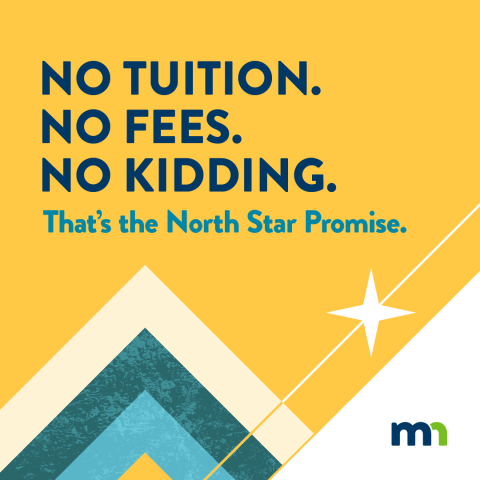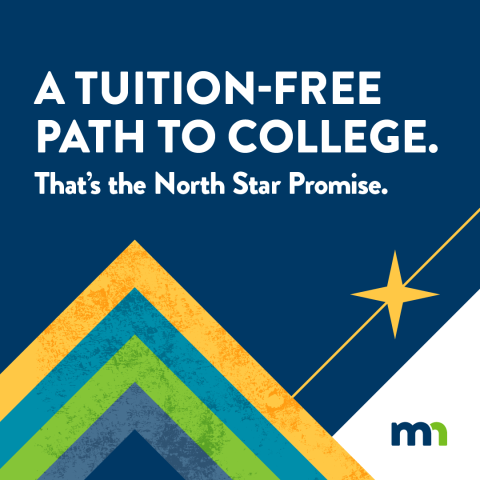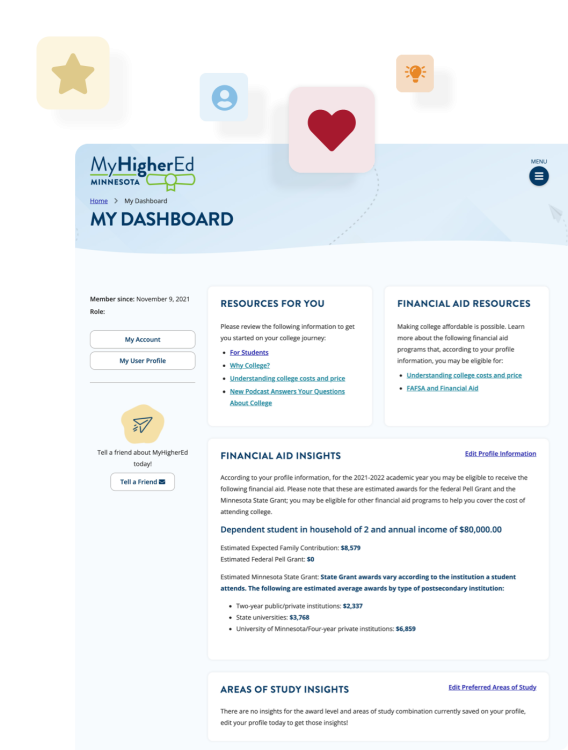Scholarships are one of two forms of financial aid that do not need to be repaid. They are awarded based on a student's academic or athletic achievement, demographic, cultural or religious background, or special skills and talents.
Main Scholarships
Given the breadth of available public and private scholarships, you might wonder where to find those that align with your background and future plans. One way is to check with the financial aid office of each college you may attend.
While an institution might offer you a scholarship as part of the financial aid package without additional paperwork, you may also need to search and apply for specific scholarships. Additionally, some colleges require students to complete the CSS Profile, (an in-depth assessment of financial need) for scholarship consideration. As a rule of thumb, expect colleges to request you fill out the FAFSA to determine your financial need.
To help you get a feel for what’s available, below is a partial list of scholarships and tuition aid:
North Star Promise Scholarship
Beginning in fall 2024, the North Star Promise (NSP) Scholarship program will create a tuition and fee-free pathway to higher education for eligible Minnesota residents at eligible institutions as a "last-dollar" program by covering the balance of tuition and fees remaining after other scholarships, grants, stipends and tuition waivers have been applied.
How much money can you receive?
There is not a limit on the maximum term, yearly, or lifetime awarded dollar amount. The amount a student shall receive is based on the "last-dollar" calculation on a term-by-term basis. You can receive up to 100% of the amount charged in tuition and required fees per term, minus all other sources of gift aid already awarded to you.
- For students earning 2-year degrees, they can receive the award for a total of 60 credits
- For students earning 4-year degrees, they can receive the award for a total of 120 credits
If funds are available, the highest need students may also receive North Star Promise Plus funds. The details on this provision of the program are still being determined.
Eligibility
Eligible students must:
- Be a Minnesota resident
- Have a family Adjusted Gross Income* (AGI) as reported on the Free Application for Federal Student Aid (FAFSA) or Minnesota Dream Act Application below $80,000
- Attend a Minnesota public higher education institution or Tribal College
- Not be in default on a state or federal student loan
- Be enrolled taking at least one credit
- Meet Satisfactory Academic Progress (SAP) standards
- Have not already earned a baccalaureate degree
- Be enrolled in a program or course of study that applies to a degree, diploma, or certificate
All Minnesota public higher education institutions and Tribal Colleges will be eligible:
- All Minnesota State Colleges and Universities
- All University of Minnesota campuses
- All Tribal Colleges
An institution may offer programs that are not eligible for Federal Title IV Aid and Minnesota financial aid. Typically, this is because the program length is too short to meet requirements for federal and state financial aid.
Application
- Complete the Free Application for Federal Student Aid (FAFSA) or Minnesota Dream Act Application
- There is no additional application beyond the FAFSA or Minnesota Dream Act Application. The eligible college or university you are attending will assess your eligibility on a term-by-term basis and award North Star Promise Scholarships to all eligible students.
Award Process
The college or university you are attending will calculate your award amount based on the eligibility requirements and award calculation. They will determine your tuition and required fee charges, subtract all other sources of gift aid (scholarships, grants, waivers and stipends) and award the remaining amount in a North Star Promise scholarship.
You shall be notified of your awarded scholarship through your college or university’s standard awarding process.
For more information:
First, review North Star Promise Scholarship Frequently Asked Questions. If you can't find the answer to your question, please send an email to NorthStarPromise.OHE@state.mn.us
Shareables
Download and share the following:
- Fact Sheets: in English, Spanish, Somali, and Hmong
- Frequently Asked Questions
- Social media: Graphics are sized 1080 x 1080 px and are available in .JPEG format. To download an image, right click on the image and select "Save Image As."




MN Academic Excellence Scholarship
The Minnesota Academic Excellence Scholarship helps students who have demonstrated outstanding ability, achievement, and potential in one of several subjects: English or creative writing, fine arts, foreign language, math, science, or social science.
Funding for this program comes from the sale of special collegiate license plates. The availability and amount of scholarships depend on that funding.
Eligibility
High school graduates must be admitted to enroll full-time in a nonsectarian, baccalaureate degree-granting program at:
- The University of Minnesota.
- A Minnesota State university.
- A Minnesota private, baccalaureate degree-granting college or university.
Application
If the institutions you are considering participate, contact them directly to apply. Students must enroll during the year of their high school graduation, but the scholarship can be renewed annually for up to three academic years if certain academic standards are met.
Private Scholarships
Many community organizations, foundations, corporations, clubs, civic, and cultural groups provide student scholarships.
If you’re looking for private sources of financial aid, you should:
- Check with your or your family’s employer, professional association, or labor union.
- Ask if your employer has an education policy that pays for employees to enroll in job-related postsecondary courses.
- Inquire at community organizations such as the Chamber of Commerce, churches, or Rotary Clubs.
- Check with your high school counselor.
Find a Scholarship
Before you accept any scholarships review the scholarship tips below. In addition, be wary of any scholarship search companies charging fees, guarantying scholarships, and asking for your credit card or checking account information to receive a scholarship.
Scholarship Tips
1. Ask questions
As you search for scholarships, asking the questions below will help you determine whether there is a good match between each scholarship program and your circumstances and educational goals.
- What is the maximum scholarship award?
- Is the scholarship one-time only or can it be renewed beyond the initial award?
- Is the scholarship based only on merit (no financial need requirement), or does it require both merit and need?
- How is financial need defined for scholarships that require need?
- How does the scholarship program define merit?
- Does the scholarship require admission to a degree-granting program?
- Does the scholarship require full-time enrollment?
- What are the other eligibility requirements?
- Is the scholarship targeted to a specific educational institution, specific field of study or major, residents of a specific geographic area, first bachelor's degree, or master's or doctoral level programs?
- Is a personal statement or essay required?
- Are letters of recommendation required?
- Is an interview required?
- What is the application process?
2. Reach out to the institutions in your community
Search for scholarships available in your community or from your educational institution. Generally, you have the best chance of receiving scholarships from these sources.
3. Be aware of scholarship deadlines
Scholarship deadlines can be six to nine months preceding the start of the academic year, while others may be closer to the start of the fall term. Some scholarship programs also accept applications for spring and summer terms.
4. Find out how your prospective college applies external scholarships
Many schools allow students to combine outside scholarships with financial aid the school has awarded with no impact on the student's financial aid package unless total aid (including the outside scholarship) exceeds the total cost of attendance. If it does, loans and work-study are reduced first, usually eliminating the need for a reduction in scholarships and grants awarded by the institution. However, some institutions reduce dollar-for-dollar scholarships or grants they have awarded when students receive outside scholarships. Check with each school to inquire about its policy.
Eligibility
To qualify for this scholarship, you must be:
- One-fourth or more American Indian;
- Minnesota resident for state financial aid purposes;
- Enrolled in an accredited college, university or vocational school in Minnesota; and
- Undergraduates must qualify for a Pell or State Grant; graduate students must demonstrate need.
Application
Students should complete the FAFSA and complete
The priority deadline for complete applications is July 1.
Other Financial Aid Resources for American Indian Students
- Native American Scholarship Database
- American Indian College Fund
- American Indian Graduate Center A national organization providing educational assistance eligible American Indian and Alaska Native graduate and undergraduate students throughout the United States
- Cobell Scholarship Program
- Ethel Curry American Indian Leadership Scholarship at the Minnesota Department of Education
- Maureen L. and Howard N. Blitman, P.E., Scholarship to Promote Diversity in Engineering
- Minneapolis American Indian Center
- Indian Health Service Scholarship Program
American Indian Tuition Waiver
The American Indian Tuition Waiver at the University of Minnesota—Morris recognizes the campus’ origins as the Morris Indian Boarding School founded in the 1800s. American Indian students admitted to the University of Minnesota—Morris may apply for this waiver by submitting the American Indian tuition waiver application and supplying acceptable documentation.
Eligibility
To qualify for this benefit, students must be accepted by the university’s admissions office, complete the American Indian Tuition Waiver application, and provide American Indian heritage documentation, which may include the following:
- Tribal registration proving membership in a federally-recognized American Indian tribe;
- Certificate of Indian blood; and
- Other legal documentation of American Indian heritage.
Application
Complete the application on the university's website. Students with questions should call (800) 992-8863 or e-mail morrisfa@morris.umn.edu.
MN Indian Scholarship
St. Paul, MN 55108
114 Decker Hall
Bemidji, MN 56601
American Indian Scholars program
The American Indian Scholars Program was established in the 2023 Legislative Session. This program provides a first-dollar tuition and fee-free pathway for Minnesotans eligible for resident tuition who are enrolled members or citizens of any federally recognized tribe or Canadian First Nation to attend a Minnesota State institution or the University of Minnesota.
Students not eligible for resident tuition who are enrolled members or citizens of a Minnesota Tribal Nation are also eligible for the program.
Eligibility
In general, students must:
- Be enrolled in an undergraduate certificate, diploma, or degree program at a Minnesota State institution or a campus of the University of Minnesota;
- Not have already obtained a bachelor's degree;
- Have fewer than 180 credits attended at the college-level; and
- Be either a: Minnesota resident who qualifies for resident tuition and an enrolled member or citizen of a federally recognized American Indian Tribe or Canadian First Nation;
- or Student who does not qualify for resident tuition but is an enrolled member or citizen of a Minnesota Tribal Nation.
Student eligibility is determined by the college. The Office of Higher Education is working with Minnesota State and the University of Minnesota on implementation of this program. We will update this page as often as possible as more information becomes available. If you are a student at the University of Minnesota, information about the program is available on the campus websites below:
If you are a student at a Minnesota State campus, information about the program is available on the websites below for some of the campuses:
- Fond du Lac Tribal and Community College
- Saint Paul College
- Minnesota State University Mankato
- Minneapolis Community and Technical College
- Ridgewater College
- Lake Superior College
- Minnesota State Community and Technical College
- Normandale Community College
- Century College
- Winona State University
If you are a student at a Minnesota State campus not listed above, contact the financial aid office and visit the system website for more information.
Scholarships for Students of Color
There are several private scholarship programs for students of color. Search your college’s website for scholarships specific to your identities.
Orphaned or Foster Children
Orphans and those who were in foster care may be eligible for an increased level of financial aid assistance. Orphans, wards of the court, and children placed in foster care any time since they turned 13 are considered independent students and are not required to submit financial information about their parents on the FAFSA.
If you attend a Minnesota state college or university, you may be eligible for a tuition waiver for certain courses or programs. Check with the college for more details.
Education and Training Vouchers (ETV) for Foster Youth
Education vouchers are federal funds made available to states through the Chafee Foster Care Independence Act. Education vouchers are intended to help current and former foster care youth pay for postsecondary education. The award amount is based on the amount of other aid the student is receiving, and an estimated living expenses budget which is a part of the application.
Eligibility
You must be under age 21 at the application due date, accepted into an accredited postsecondary program, and meet at least one of the following requirements:
- In foster care on or after your 16th birthday;
- Adopted from foster care after your 16th birthday;
- In foster care on or after your 16th birthday when a relative accepts a transfer of permanent;
- legal and physical custody through a juvenile court order; and
- Are or were under state guardianship on your 18th birthday.
Application
Applications are available on the Minnesota Department of Health website. Applications for the 2021-2022 school year are being accepted until April 1, 2022. Complete the application for each year you need money for school.
To apply for an initial voucher, you must attach a copy of your financial aid award, FAFSA, postsecondary school acceptance letter, and most recent transcripts. Students may reapply for education/training vouchers every year until age 23 if they are participating in the education/training voucher program and making satisfactory progress.
Make sure you collect all the required documents before you submit your application.
Education and Training Voucher Program
Financial Aid for Students in Specific Programs
Health Professions Programs
Various federal scholarship and loan programs are available for students interested in health professions, such as nursing, dentistry, pharmacy, optometry, or medicine. Campus-based programs include the Health Professions Student Loan Program, the Primary Care Loan Program, Loans for Disadvantaged Students Program, and Nursing Student Loan Program.
Application
Students should contact the financial aid office at the school where they are enrolled or intend to apply for admission.
For other financial aid resources from the Health Resources and Services Administration or more information about their programs, visit their website or contact them with your questions.
Minnesota Paramedic Scholarship
The Minnesota Paramedic Scholarship is a temporary financial aid program for Minnesota residents completing a paramedic diploma or degree. The program will provide up to 600 scholarships of $5000 each starting Fall 2024 to be awarded by June 30, 2026.
Eligibility
Eligible students are Minnesota residents attending an eligible paramedic program. Students must enrolled in any of the following paramedic program courses to receive the scholarship:
- Rochester Community and Technical College
- Emergency Medicine Paramedic AS (75 credits)– 20-month program in affiliation with the Mayo Clinic School of Health Sciences.
- Minnesota North College
- Paramedic AA Degree (67 credits)
- Paramedic Diploma (52 credits)
- Century College
- Paramedic Fire Science AAS (68 credits)
- Paramedic AAS (60 credits)
- Paramedic Diploma (47 credits)
- Anoka Technical College
- Paramedic AAS Degree (60 credits)
- Paramedic Diploma (45 credits)
- Ridgewater College
- Paramedic AAS Degree (60 credits)
- Paramedic Diploma (46 credits)
- Saint Cloud Technical and Community College
- Paramedicine AAS Degree (60 credits)
- Northland Community and Technical College
- Paramedic AAS Degree (60 credits)
- Paramedic Diploma (48 credits)
- South Central College
- Intensive Care Paramedic Technician AAS Degree (67 credits)
- Intensive Care Paramedic Technician Diploma (58 credits)
- Inver Hills Community College
- EMS AS Degree (70 credits)
- Paramedic Diploma (40 credits)
All eligible programs require students to be a current Emergency Medical Technical (EMT) license holder before starting the program. Each institution has individual prerequisite requirements. Please review the individual program requirements to enroll with your selected institution.
If you are not an EMT license holder but would like to become a paramedic, you may still be able benefit from the scholarship if you take action quickly. All of the institutions with eligible programs offer EMT programs that can be completed before the start of their paramedic programs.
Applications
Choose the application link in accordance to your program start term:
- 2024-2025 Paramedic Scholarship Application: for students starting in Fall 2024, Spring 2025 or Summer 2025
- 2025-2026 Paramedic Scholarship Application: for students starting in Fall 2025, Spring 2026 or Summer 2026
There are only 600 scholarships are available. Secure yours as soon as possible. Submit your application today!
Award Process
Applications will be reviewed in order of date submitted with confirmation of enrollment from the institutions.
Student award notices will be sent from the Minnesota Office of Education.
Scholarship funds will be sent out starting Fall 2024. All funds will be sent to institutions to be applied to the student’s account.
Minnesota Health Professions Loan Forgiveness
The Minnesota Department of Health’s Office of Rural Health and Primary Care administers loan forgiveness programs for the following health professionals:
- Rural and Urban Physicians: primary care residents or students (family practice, internal medicine, OB/GYN, pediatrics, psychiatry).
- Mid-level Practitioners: nurse practitioner students, physician assistant students, certified nurse midwife students, nurse anesthetist students, or advanced clinical nurse specialist students.
- Nurses: licensed practical nurse students or registered nurse students.
- Dentists: dental students or licensed dentists.
- Pharmacists: students or residents in a pharmacy program or licensed pharmacists
- Allied Health Care Tech Faculty: students studying to become allied health care instructors.
- Nurse Faculty: students studying to become nursing instructors.
Application
Application forms and more information are available on the Minnesota Department of Health website.
- Early Application Cycle for Selected Professions: September 13 - November 22
- Regular Application Cycle for All Professions: November 1—January 7, 2022
If you have any questions, please send an email to: health.loanforgiveness@state.mn.us
Minnesota Aspiring Teachers of Color Scholarship Program
Minnesota Aspiring Teachers of Color Scholarship Pilot Program provides postsecondary financial assistance to eligible undergraduate and graduate students who are preparing to become teachers, have demonstrated financial need, and belong to racial or ethnic groups underrepresented in the state’s teacher workforce.
The annual award for full-time students is up to $10,000. Awards for students enrolled less than full-time are prorated on a per-credit basis. For undergraduate students, full-time means enrollment in a minimum of 15 or more credits per term; for graduate students, full-time means enrollment in a minimum of six graduate credits or equivalent. Students may receive up to $25,000 in a lifetime.
ATCS Eligibility
To be eligible, students must:
- Be enrolled at an eligible institution located in Minnesota in a:
- Professional Educator Licensing and Standards Board (PELSB) approved teacher preparation program seeking initial licensure; or
- Two-year program specifically designed to prepare early childhood educators;
- Be a person of color or American Indian;
- Be meeting Satisfactory Academic Progress (SAP) requirements as defined by the institution;
- Complete a Free Application for Federal Student Aid (FAFSA) or MN Dream Act application for aid year; and
- Demonstrate financial need.
Eligible Institutions with Teacher Preparation Programs
- Augsburg University
- Bemidji State University
- Bethany Lutheran College
- Bethel University
- Carleton College
- College of St. Benedict
- College of St. Scholastica
- Concordia College, Moorhead
- Concordia University, St. Paul
- Crown College
- Gustavus Adolphus College
- Hamline University
- Martin Luther College
- Metropolitan State University
- Minnesota State University, Mankato
- Minnesota State University, Moorhead
- North Central University
- Southwest Minnesota State University
- St. Catherine University
- St. Cloud State University
- St. John's University
- St. Mary's University of Minnesota
- St. Olaf College
- University of Minnesota, Crookston
- University of Minnesota, Duluth
- University of Minnesota, Morris
- University of Minnesota, Twin Cities
- University of Northwestern, St. Paul
- University of St. Thomas
- Walden University
- Winona State University
Eligible Minnesota Institutions with Two-Year Early Childhood Education Programs
- Central Lakes College
- Dakota County Technical College
- Fond Du Lac Tribal and Community College
- Hennepin Technical College
- Leech Lake Tribal College
- Minneapolis Community and Technical College
- Minnesota North College
- Minnesota State College-Southeast
- Minnesota State Community and Technical College
- Minnesota West Community and Technical College
- Northland Community and Technical College
- Northwest Technical College
- Pine Technical College
- Ridgewater Community College
- Rochester Community and Technical College
- Saint Cloud Technical and Community College
- South Central College
- Saint Paul College
- Rasmussen University
ATCS Application
If interested in applying to this program, please complete the FAFSA or MN Dream Act application before completing the Minnesota Aspiring Teachers of Color Scholarship application. The priority deadline is June 17th, 2022.
You should only complete the 2022-2023 Student Section of the application and contact your school’s Financial Aid Office to submit the College or University Section of the application.
Complete applications must include the following:
- Student Section including all the required information that is signed and dated;
- College or University Section completed by an authorized representative at the college or university you attend that includes all of the required information; and
- Completed Free Application for Federal Student Aid (FAFSA) or Minnesota Dream Act application.
Incomplete applications will not be processed.
Need Help?
If you have questions and would like to request application forms, please contact:
Minnesota Aspiring Teachers of Color Scholarship Pilot Program
Minnesota Office of Higher Education
1450 Energy Park Drive, Suite 350
St. Paul, MN 55108
Tel: (651) 642-0567 or (800) 657-3866
Fax: (651) 642-0675
ACTS Selection Process
Scholarships should be awarded to eligible applicants who submitted their application by the deadline. If there are insufficient funds, awards are prioritized using a combination of the student’s Expected Family Contribution (EFC) and application completion date:
- Eligible applicants with the lowest EFC are awarded first
- Eligible applicants with identical EFCs are prioritized by application completion date
Eligible applicants with complete applications received by the priority application deadline who are not awarded are placed on a waiting list by order of application completion date. Complete applications from eligible applicants received after the priority application deadline are placed on the waiting list by order of application completion date.
Applicants selected to receive an award are expected serve as a full-time teacher in Minnesota after completing the program for which the grant was awarded.





